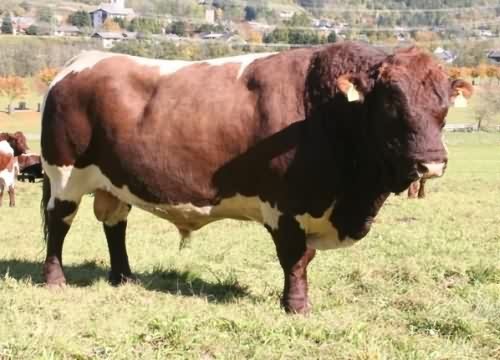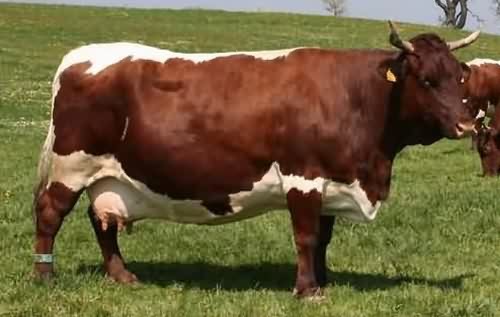Dairy Meat Breeds - 3
Performance Dual Purpose Breeds For Crossbreeding
MRY (Meuse Rhine Yssel)
The Meuse-Rhine-Yssel cattle (MRY) is a red and white dairy meat breed that originated from Overijssel and Noord-Brabant in The Netherlands. MRY cattle have been registered at NRS (CRV) since 1874, and in 1905 was recognized as a breed and the herd book was started. The two breeding regions of the MRY are the West-Achterhoek, Salland, Twente and in south-west of the province Drenthe (MRY-East); and the east of the province Noord-Brabant under MRY-South.
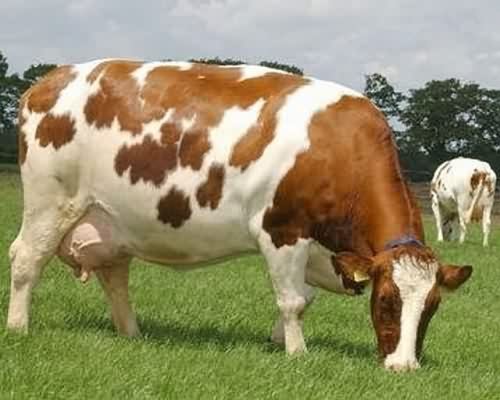
The MRY has good fertility and calve easily with good rump angle. It has strong claws and in general, the cows are strong, calm, long living and healthy. Up to the ‘60’s and ‘70’s, the MRY represented 25% of all Dutch dairy cows (more than 500,000). Since then, the number of purebred MRY decreased rapidly, with a strong decrease since 1999. In 2004, approximately 14,000 cows with at least 87.5% (7/8) MRY-blood were registered. In 2008 the number increased slightly up to 15,000 cows. In the ‘80’s, MRY farmers started crossbreeding with Red Holstein bulls from Canada. The milk production and the conformation of the udder improved considerably. With the introduction of the European milk quota system in 1984, the MRY became more competitive again. This is because the protein content of MRY milk is higher and its fat/protein ratio is more favorable than of the Holstein, giving better profits. Economic comparisons consistently show that costs of milk production with MRY cattle are relatively low. Economic figures indicate that currently farmers with MRY cows earn 1 to 2 cents more per kg milk than farmers with Holstein-Friesians. Also as a dual purpose breed, the calves grow faster and the cows are stronger muscled when slaughtered giving additional profits. The most optimal production system for MRY is the low-input system with a high proportion of silage, or a system where the cows are grazing constantly. In 1994 the breed organization MRY-East was founded to promote the interests of the MRY cattle by selecting more MRY bulls for a better and broader genetic base. A separate breed organization MRY-South was founded in 1992 that is focused more on efficient production of milk. Currently the weight of milk yield in the index is 35%, whereas the functional traits, durability and health have a weight of 25% as well as conformation. Muscling has a weight of 15%. In 2005 only 3454 purebred MRY-calves were registered and more than 50,000 calves with less than 50% MRY-genes. Between 1960 and 2008, semen of 420 MRY sires has been stored in the Dutch Gene bank of CGN. This will also help to preserve certain genes for the next generations. (Adopted from Yvette de Haas, with help of Rita Hoving-Bolink, Myrthe Maurice-van Eijndhoven, Debbie Bohte-Wilhelmus, Henk Sulkers and Sipke-Joost Hiemstra of EURECA)
In 2011, 7,190 MRY Herdbook cows produced an average of 6,832 kgs. of milk in 332 days with 4.44% Fat and 3.69% Protein. (ICAR)
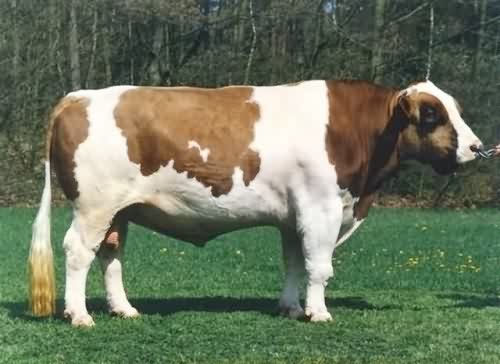
NORMANDE
The Normande is the result of progressive improvement of various local populations in Normandy in France. It was standardised in the 19th century and identified as long ago as 1883 with the founding of the Pedigree Book and creation of the Normande Herd Book (HBN*), France’s first herdbook. The origins of the Normande breed is the result from cross-breeding the Cotentine, Augeronne, and Cauchoise breeds into one homogeneous breed. The Cotentine (red brindled coat) was a tall cow, heavier than normal, and above all an excellent milk cow. The Augeronne breed (“mottled white” coat) was smaller and known for its quality as beef cattle, less coarse and more readily fattened than the Cotentine. The “Cauchoise” (red pied coat, with Flemish blood) had almost entirely white head (at least two-thirds). The Durham Shorthorn from England was crossed with the Normande to develop earlier maturing, better conformed, less coarse, and easily fattened cattle. The Durham was used for roughly 40 years, until 1880 in an irregular manner. But the breeders who succeeded were those who essentially relied on the Cotentine breed in their selections. The last quarter of the 19th century marked the start of a new era during which the Cotentine breed started to impose itself as the main factor in the improvement of the Normande breed. From 1877-1928, exports were made to South America while in 1946, the first Artificial Insemination in France was carried out on a Normande cow. In 1952 the SCTN (Normande Bull Control Board) was established to progeny test young Normande bulls where 350 cows were inseminated with the intention of obtaining 40 daughers to test for their first lactation. In 1958 the GNA (National Buying Group) was founded to make it easier to acquire males for the semen production centres where in 1986 it was absorbed by the GNA*, now called “Génétique Normande Avenir” (Normande Genetic Future).
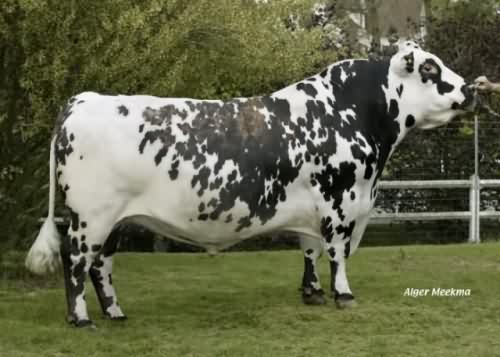
The Normande is a dual-purpose breed coming from a high-performance selection scheme whose objective (among others) is the improvement of dairy qualities while preserving beef qualities. It is the third most popular milk breed in France, after the Holstein and the Montbéliarde. Its milk is rich in fat and in protein; it is highly sought-after by dairy produce makers and has contributed to the reputation of Normandy’s creams and cheeses. The Corrected lactations Average in 2007 from 230,723 records 7,326 Kg milk/year, 4.28% Fat content, 3.63% Protein content. The Standardized milk with 7% solids Kg milk/year is 8,100 (Source FCL). The genetic levels in the controlled population are rising regularly: the annual genetic progress is +80kg of milk, with no deterioration in protein, butterfat, or protein values. Between 1997 and 2007, milk production (corrected milk yields – FCL* data) went from 6,504kg to 7,326kg per cow per year. The richness of its milk in cheese-yielding proteins (the B Kappa variant) ensures the Normande's superiority over most other milk breeds. Caseins, the main protein in cows' milk, are the basis for conversion to cheese. The BBB combination, which gives the best yield, is strongly present in Normande cow's milk. The richness of the milk, especially in protein, is a real advantage for breeders who are paid on this basis. In 2002, the Normande, with 34.3 grammes/litre of pure protein, held a clear advantage over the other breeds, notably the Montbéliarde (+1.7 g/l) and the Holstein (+2.6 g/l).
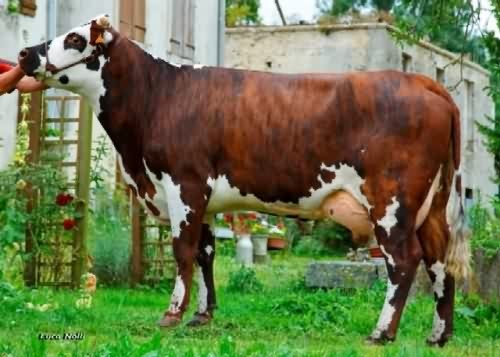
The males are valued as veal calves, steers and young bulls. Even after several lactations, the females produce tasty meat known for its flavour and marbling. The carcasses, which are heavy and well shaped, are much appreciated by meatpackers. Since 1992, a Normande Quality Label(FQRN) has promoted Normande meat, which is so tender, marbled, and tasty, that it was judged best meat by a Gault et Millau jury. This gives the producer a premium of +10% to +20% compared with the market price. In terms of breeding qualities, the Normande is characterised by its ability to make good use of fodder, its fertility, its longevity, and its hardiness. The average weight of female animals is 750kg, the average height is 145cm to the sacrum.
In France there are almost 2 million heads, 600,000 of which are cows mostly spread through the western part of the country. In 2002, 500,000 First Artificial Inseminations were recorded, and 300,000 cows were registered at the milk control council. The Normande is present in many countries specially in South America, where it was exported at the start of the 20th century. Colombia is the Normande's second home with 1.2 million heads together with Normande x Zebu crosses. The Colombian association of Normande breeders (ASONORMANDO Colombiano) ensures genealogical monitoring of the animals. In Uruguay, there are 300,000 head of purebreds and crosses. The Normande-Zebu cross allows the hardiness of the Zebu to be combined with the production characteristics of the Normande and has been carried out also in Brazil, Paraguay, and other tropical countries. More than 15 other countries such as Argentina, UK, USA, Belgium, Brazil, Chile, Ecuador, Portugal, Ireland and others, have more than 100,000 heads of purebreds and crosses. The United States holds strong development potential for the breed both for milk production, and beef production from pastures. (Author - UPRA Normande)
Simmental
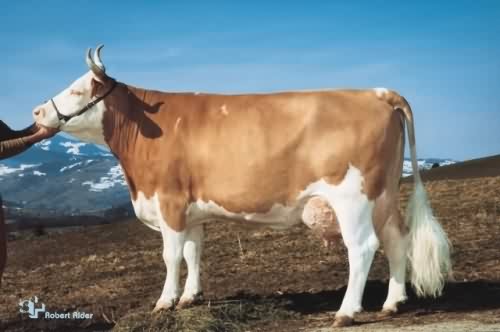
The Simmental is the best dairy-meat or dual purpose cattle breed in the
world for intensive production. The breed originated in the Simme
valley (thal in German) in the Bernese Oberland in Switzerland during
the 19th century. The first herd book was established in the Swiss
Canton of Berne in 1806 while the Swiss Red and White Spotted
Simmental Cattle Association was formed in 1890. Even before the formal
breed recording was started, there were indications of the presence of
excellent red and white speckled cattle already in the area. The first
Simmentals are actually an excellent triple purpose breed - draft,
dairy and meat, up to until the widespread mechanization of agriculture
in the 1960's when draft usage was diminished.
The Simmental is now found worldwide and has been used to improve other breeds and develop new ones. In Germany, it was used to develop the Fleckvieh
that is now even more productive than Simmental in many areas of
intensive production. In Austria, Simmental and German
Fleckvieh genetics were used to develop the Austrian Fleckvieh. In Italy, the Simmental was used in the development of the Pezzata Rossa breed, while in France the Pie Rouge de l'Est, the Montbeliarde, and the Abondance were influenced. There are also Simmental strains in Russia, Poland, Czech Republic, and other eastern European countries.
In
the Americas, the U.S., Brazil, Canada and Mexico have large
numbers of Simmental. However, the utilization is mostly for beef
production. In the U.S., the Simmental is now seen not only in its
original red and white speckled color, but also in other colors mostly black for the red
color, due to the introgression from the Angus breed. It has also been
crossed with Zebu breeds like the Nellore and Brahman specially in
Brazil, Mexico, and the hotter areas of the U.S. to cope with the
tougher environments. The Simmental is beginning to make some inroads
in the U.S. dairy industry as a crossing breed to attenuate the effects
of high inbreeding in Holstein herds.
In South Africa where
it was introduced in 1895, the Simmental is used both for dairy-meat or
dual purpose production, and for pure beef breeding often in crosses
with hardier tropical breeds. The Simmental is also widely used in
Australia and New Zealand, with Zebu crossings in tropical areas of
Australia.
On 24 September
1974, the World Simmental Federation was founded in
Zagreb,Croatia on the occasion of the 11th general meeting of the
European Simmental Federation. Delegates from Argentina, Australia,
Austria, Brazil, Bulgaria, Canada, Czechoslovakia, Germany,
France, Great Britain, Hungary, Iraq, Ireland, Italy, New Zealand,
South Africa, Switzerland, Uruguay, USA and Yugoslavia were present.
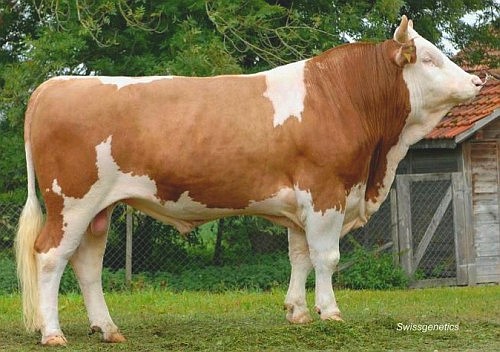
Today in Switzerland, the Simmental has forked into different strains focused on different production systems. The Simmental Original (about 10% of herdbook) is fullblooded Simmental and used for both dual purpose dairy meat production, and beef production. The purebred Simmental (about 50% of herdbook) can have up to not more than 14% blood of other breeds, usually Red Holstein or Montbeliarde, and is used for dual purpose dairy meat production. This kind of registration with non-pure Simmental blood has been accepted since January 1994. The Swiss Fleckvieh (about 40% of herdbook) has Red Holstein blood of from 14 to 74% and production has emphasis on milk.
Crossing with the Montbeliarde occured during the mid 1960's, and with Red Holstein on a wider scale since 1967. In 1978, breeders wanting to preserve and promote the fullblood Simmental breed, without any infusions from other outside breeds, formed the 'Schweizerische Vereinigung zur Erhaltung und Förderung der reinen Simmentaler Fleckviehrasse'
The average milk production in 2007 in Switzerland of 156,937 Simmental cows in 334 days was 7,618 liters with 4.00% Fat and 3.26% Protein. The Average Daily Gain of Simmental in feedlots is at least 1.3 kilograms.
Fleckvieh
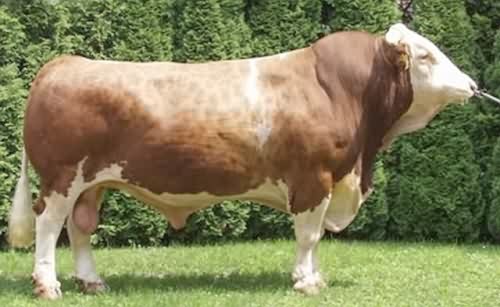
Montbéliarde
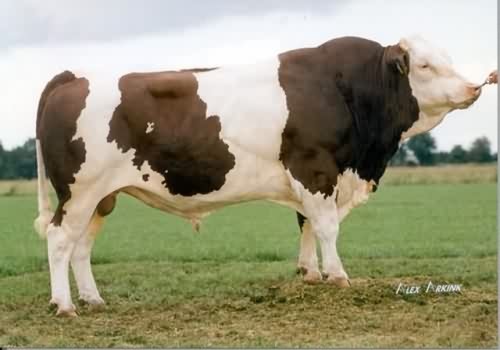
Hinterwälder
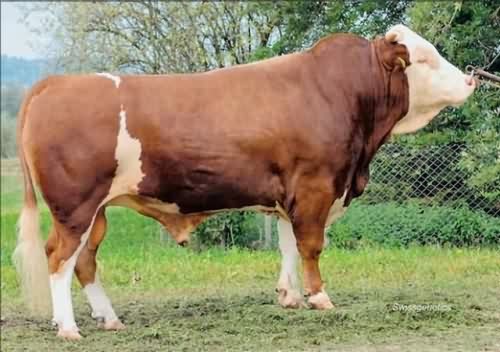
Pie Rouge des Plaines
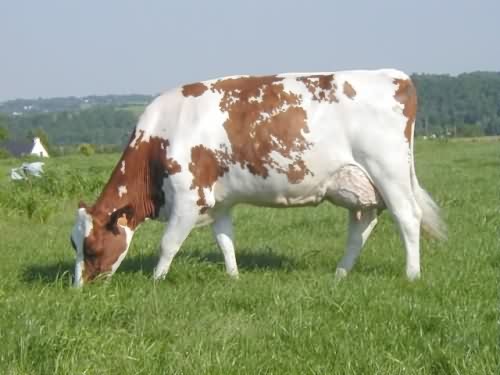
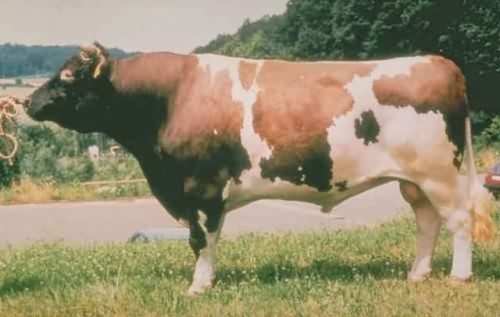
Friesian
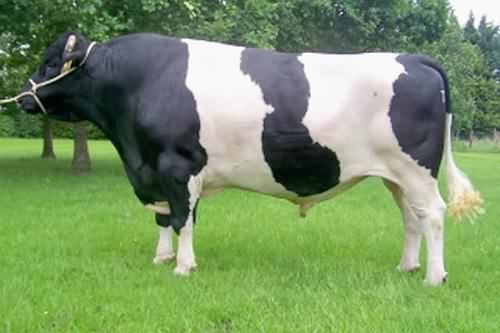
Vorderwälder
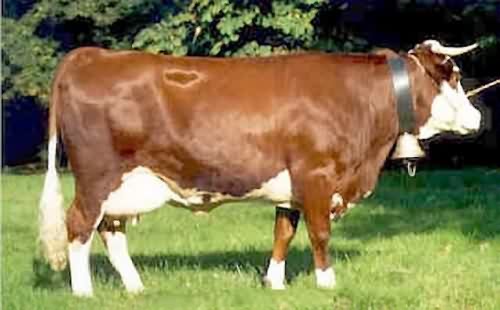
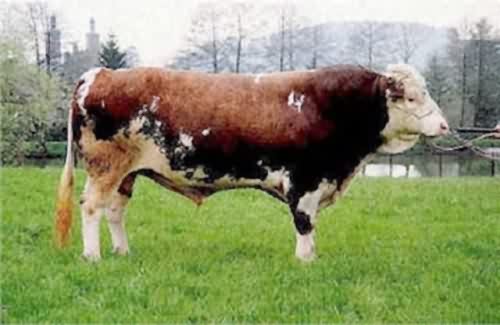
Pinzgauer
